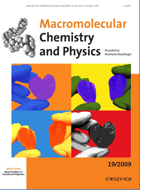Highlight on self-healing SupraB™ materials
02-02-2012
 After gaining recent attention in the international newspapers, such as the Daily Telegraph in the UK and the Repubblica in Italy, SupraPolix' managing director Tonny Bosman co-authored a feature article in Wiley's Macromolecular Chemistry and Physics journal. In this article, the hottest approaches in supramolecular self-healing materials are highlighted and have been rewarded with the issue's front-cover as displayed on the right.
After gaining recent attention in the international newspapers, such as the Daily Telegraph in the UK and the Repubblica in Italy, SupraPolix' managing director Tonny Bosman co-authored a feature article in Wiley's Macromolecular Chemistry and Physics journal. In this article, the hottest approaches in supramolecular self-healing materials are highlighted and have been rewarded with the issue's front-cover as displayed on the right.
The article addresses the fact that sophisticated polymeric materials with "responsive" properties, such as self-healing, are reaching the market. Supramolecular polymers that owe their mechanical properties primarily to reversible hydrogen bonding interactions have frequently been employed as self-healing materials. The quadruple hydrogen bonding ureidopyrimidinone (UPy or SupraB™) unit is a particularly effective and versatile design motif, since it forms very strong but reversible linkages, and can be incorporated into virtually any type of polymer backbone, leading to materials with increased mechanical properties. In this feature article supramolecular polymers are presented, with an emphasis on those based on the UPy-unit, and their use in self-healing applications is highlighted and discussed.
Autonomous healing of a 15 wt% UPy hydrogel: from left to right: initial heart shaped hydrogel, flexibility and elasticity of the hydrogel, the hydrogel cut in two parts, and the hydrogel heart mended by pressing both original halves together.
Bosman and co-authors conclude that: "Supramolecular polymers are materials that are well-suited to display self-healing properties. The non-covalent interactions that are the hallmark of these polymers are dynamic, so that the materials become stimuli responsive and can be addressed by heat, light, or even contact pressure triggers. Therefore, supramolecular materials have the prime advantage that the self-healing properties are intrinsic to the material, so that there is no need for (reactive) additives such as (toxic) monomers or catalysts nor for the engineering of specific chemical reactions to effect the healing process.", additionally they propose: "The intrinsic self-healing in supramolecular materials may be important for structures that are not easily accessible, such as those applied in aerospace or in oil and gas winning, or in materials that are not only difficult to repair, but that also do not directly appear to be damaged, such as fiber-reinforced polymer composites. Furthermore, more down-to-earth repair of adhesive coatings may as well benefit from the use of supramolecular materials. A simple thermal rejuvenation would do in these cases."
SupraPolix offers a new concept in the world of plastics by separating the processability demands from the material demands: incorporation of already a small amount of its product SupraB™ in existing plastics dramatically simplifies their processing. As a consequence, production can be cheaper and faster, whereas the consumer will benefit from innovated products with unique material properties like self-healing. Moreover, combining SupraB™ with bio-based materials allows producers to comply with the environmental constraints of the near future without any concession to the quality of the materials.

